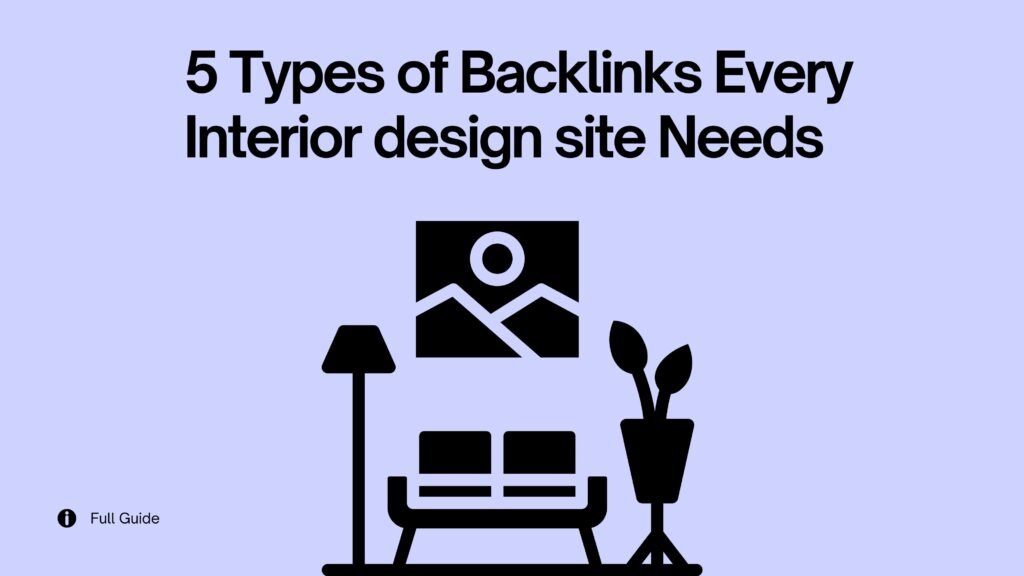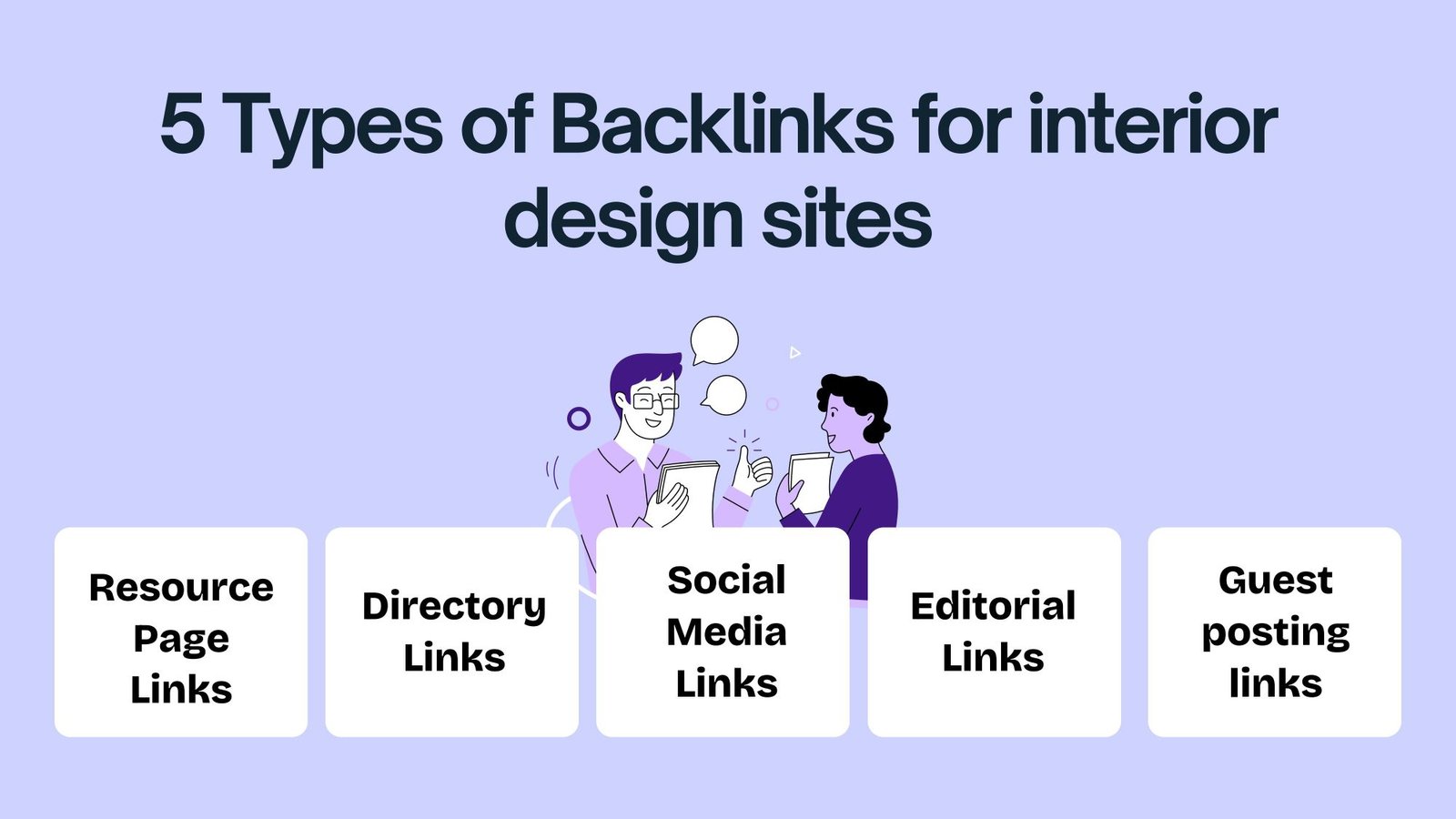
Backlinks are a powerful asset in elevating the online presence of any interior design website. More than just improving search engine rankings, the right backlinks help drive highly targeted traffic, strengthen brand credibility, and signal trustworthiness to both users and search engines. In a visually driven and competitive niche like interior design, building a strong backlink profile is essential for standing out.
In this guide, we’ll break down five essential types of backlinks that every interior design site should actively pursue. These backlink sources not only boost your EEAT (Experience, Expertise, Authoritativeness, and Trustworthiness) signals but also expand your reach and visibility across the digital landscape.
Why Backlinks Matter for Interior Design Sites ?
In today’s highly visual and competitive interior design industry, having a beautiful portfolio is just the beginning. To truly stand out and attract ideal clients, you need more than stunning visuals—you need a strong digital presence backed by EEAT principles: Experience, Expertise, Authoritativeness, and Trustworthiness. One of the most effective ways to strengthen that online credibility is through high-quality backlinks.
Backlinks: A Core Element of Google’s EEAT Framework
Search engines like Google assess a website’s credibility and ranking potential based on multiple EEAT signals—and backlinks are among the most powerful. When your content is featured or referenced by reputable sources such as interior design magazines, architecture blogs, home improvement platforms, or trade associations, it sends a strong trust signal. These inbound links act as third-party endorsements that tell Google and users your content is valuable, reliable, and created by an expert.
This not only boosts your search engine visibility but also helps you rank higher for valuable keywords like “modern living room design ideas”, “interior designers in [Your City]”, or “eco-friendly home décor trends”—making it easier for potential clients to find your services.
Build Trust & Industry Credibility
For interior designers, trust plays a crucial role in converting website visitors into paying clients. When your content is cited by well-known and trusted websites, it demonstrates that other professionals respect and reference your work. This positions you as a credible thought leader in the industry, enhancing your authority both online and offline.
In an industry driven by emotional and financial investment, clients are more likely to hire designers who are perceived as trusted experts. Strategic backlinks help reinforce that perception.
Showcase Real-World Experience and Professional Validation
Google and potential clients alike value real-world experience. Backlinks from relevant and high-authority domains show that your insights and design knowledge are not just theoretical—they’re being recognized and shared across the professional landscape. This external validation highlights your hands-on expertise and contributes to a more robust online reputation.
Pro Tip: Start building backlinks by contributing guest posts to reputable design blogs, getting featured in digital magazines, joining interior design directories, and networking with home décor influencers. Focus on quality over quantity—one backlink from an authoritative source can outweigh dozens from low-quality websites.
Quick Overview of the Backlink Types in Interior Design Site
Backlinks play a crucial role in enhancing the visibility and authority of interior design websites. Diverse backlinks contribute to improved search engine rankings, increased traffic, and greater credibility within the design community.
- Authority Level: High-quality backlinks from reputable sources boost site credibility.
- Relevance: Links from design-related content enhance contextual relevance.
- Link Source: Diverse sources, including blogs, directories, and social media, enrich link profiles.
- Context: Contextual links within relevant content provide better SEO value.
- Placement: Strategic link placement in content or resource pages maximizes impact.
5 Must-Have Backlinks to Boost Your Interior Design Website’s Authority

In the design world, first impressions matter—and your website is often the first touchpoint for potential clients. But beautiful visuals alone won’t get you top rankings on Google. What truly builds visibility, authority, and trust is a strong backlink profile—especially one tailored to the interior design niche.
To strengthen your EEAT (Experience, Expertise, Authoritativeness, and Trustworthiness), focus on acquiring these five strategic types of backlinks that align with the unique nature of interior design:
1. Guest Posts on Design & Architecture Blogs
What They Are:
Guest post backlinks are earned when you write insightful articles for established blogs or online magazines in the design, architecture, or home improvement space. These articles typically include a link back to your website within the content.
Why They’re Crucial:
Position you as a design expert and thought leader
Bring in niche, referral traffic
Enhance keyword relevance via contextual backlinks
Tips:
Pitch to reputable blogs like Design Milk, Freshome, or ArchDaily
Focus on topics like color trends, sustainable interiors, or small space solutions
Use natural, non-spammy anchor texts
2. Resource Page Backlinks
What They Are:
These are links from curated web pages listing top tools, blogs, or services for homeowners, decorators, or architects.
Why They’re Crucial:
Come from pages built to recommend credible resources
Elevate your domain authority and perceived expertise
Tips:
Search for terms like “interior design resources” or “best home decor blogs”
Offer useful content like free design templates, layout planners, or client case studies
Make your pitch about how your resource genuinely adds value
3. Design Awards & Featured Listings
What They Are:
Backlinks from websites that host design competitions, give awards, or feature top-rated designers. Winning or even being shortlisted often includes a link to your site.
Why They’re Crucial:
High-authority and editorial-style links
Reinforce your credibility and showcase achievements
These mentions often drive high-converting traffic
Tips:
Submit your work to platforms like Dezeen Awards, Interior Design Best of Year Awards, or Houzz Awards
Make sure your portfolio is polished and project descriptions are compelling
Even being featured (not winning) can earn you valuable backlinks
4. Local and Niche Directories
What They Are:
These include reputable online directories focused on the interior design industry or your geographic area.
Why They’re Crucial:
Strengthen your local SEO and improve visibility on Google Maps
Help potential clients find and contact you easily
Tips:
Add your business to high-quality directories like Houzz, InteriorDesign.net, DesignRush, or Architizer
Use consistent NAP (Name, Address, Phone Number) data
Avoid low-quality or spammy directories
5. Editorial & PR Mentions (Earned Media)
What They Are:
Natural backlinks from journalists, bloggers, or influencers who mention your brand or work in online publications without you asking for it.
Why They’re Crucial:
- These are the highest quality links in Google’s eyes
- Show real authority, influence, and trust
- Can lead to significant brand exposure
Tips:
- Create standout content like trend forecasts, before-and-after transformations, or home tours
- Use platforms like HARO or Qwoted to get quoted as an expert in media pieces
- Network with influencers or editors in the home and lifestyle space
Backlinks aren’t just about quantity—they’re about quality and relevance. For an interior design website, links from industry-respected platforms, award sites, and credible directories can elevate your site’s visibility and build lasting trust with both users and search engines. Invest time in building the right relationships and publishing standout content, and your backlink strategy will pay long-term dividends.
Bonus Tips for Getting Quality Backlinks for Interior Design Site
Bonus Tips: How to Earn High-Quality Backlinks for Your Interior Design Website
In the fast-evolving world of interior design, getting featured on authoritative platforms can significantly boost your online presence. High-quality backlinks not only improve your website’s search engine rankings but also enhance your credibility, trustworthiness, and industry authority—all core elements of Google’s EEAT framework. Go beyond basic link-building and implement these advanced, interior-design-specific strategies to strengthen your backlink profile.
1. Leverage Visual Content to Earn Organic Links
Interior design is a naturally visual niche—use that to your advantage. Create high-quality infographics, mood boards, or portfolio showcases that stand out and offer real value to other designers, bloggers, or online publications.
Pro Tips:
Use tools like Canva, Figma, or Adobe Illustrator to craft visually stunning infographics or visual guides (e.g., color theory, room layout tips, seasonal trends).
Share these assets on Pinterest, Instagram, and design communities like Behance or Houzz.
Reach out to design bloggers, home decor websites, and influencers offering them the visuals in exchange for a proper credit link to your website.
2. Collaborate with Influential Designers for Credible Mentions
Partnering with established interior designers or home decor influencers can generate high-authority backlinks through interviews, guest posts, and co-created content.
Actionable Ideas:
Feature designers in a “Top Designers to Follow” blog post or a design trend forecast.
Co-create a webinar or Instagram Live session discussing design tips or industry challenges.
Use LinkedIn or Instagram to pitch your collaboration, highlighting mutual benefits and audience crossover.
Such partnerships signal industry trust and experience, making your site more authoritative in the eyes of both users and search engines.
3. Build a Comprehensive Interior Design Resource Hub
Creating a well-structured resource library—filled with downloadable guides, tutorials, case studies, and design templates—can earn backlinks from universities, design institutions, forums, and niche websites.
Why it works:
- Educational and resourceful content aligns directly with Google’s EEAT values.
- It provides consistent long-term value, earning evergreen backlinks from reputable sources.
Use SEO tools like SEMrush or AnswerThePublic to identify common user queries, then create detailed pages or blog posts that directly answer those questions. Promote your hub on design forums, Quora, and Facebook groups to get noticed.
4. Host Expert-Led Virtual Design Workshops
Free or paid online workshops on interior design topics—like “Space Optimization Tips for Small Homes” or “How to Create Mood Boards”—can position you as an expert and generate media and blog mentions.
Steps to take:
- Host events via Zoom, Google Meet, or Instagram Live.
- List your workshop on event sites like Eventbrite, relevant community boards, and industry newsletters.
- Collaborate with guest speakers or influencers to cross-promote and multiply your reach and backlinks.
- Workshops not only drive direct traffic but can also be covered by design publications, blogs, or local media—earning you natural, high-authority backlinks.
5. Build Community Engagement Through Forums and Niche Groups
Engage in online communities where interior design is frequently discussed. Forums and groups offer long-term backlink potential when you consistently contribute thoughtful answers and insights.
Where to Participate:
- Reddit’s r/InteriorDesign, Houzz discussions, and Facebook groups for interior professionals or home enthusiasts.
- Leave helpful comments or suggestions with links to your relevant blog post or resource page.
- Ensure your profile or signature contains your website link, so even passive engagement creates visibility.
Over time, this boosts your site’s trust signals and helps you gain contextual backlinks as members naturally reference your expertise.
Final Thought: Focus on Value First, Links Will Follow
In interior design, authority is built through visuals, trust, and demonstrated expertise. The most successful backlink strategies stem from creating genuinely useful, high-quality content that others naturally want to reference. Whether through engaging visuals, smart collaborations, or educational content, your goal should always be to provide value first—the backlinks will follow.
Frequently Asked Questions
What are the most important types of backlinks for an interior design site?
For an interior design site, the most important backlinks include those from industry-specific directories, design blogs, and reputable home improvement websites. These links help establish authority and trust in the design community.
How can I get backlinks from design blogs?
To get backlinks from design blogs, consider reaching out with guest post proposals or offering to collaborate on content. Building relationships with bloggers through social media can also increase your chances of earning valuable backlinks.
Are social media backlinks valuable for interior design websites?
While social media backlinks are typically nofollow, they can still drive traffic and increase brand visibility. Sharing engaging content on platforms like Instagram and Pinterest can indirectly boost your site’s authority and attract natural backlinks.
How do I ensure the backlinks I get are high-quality?
High-quality backlinks come from authoritative and relevant sites. Focus on earning links from well-respected design publications, industry associations, and educational resources to ensure they positively impact your SEO.
Can local business directories help with backlink strategies for interior design sites?
Yes, local business directories can be beneficial for interior design sites, especially if you offer services in specific areas. Listing your business in local directories can improve local SEO and attract clients searching for design services nearby.
What role do testimonials play in building backlinks?
Testimonials can be a great way to earn backlinks. By providing testimonials for products or services you use, you can often get a link back to your site from the company’s website, enhancing your backlink profile.
